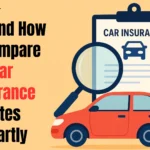For many car enthusiasts, our cars are more than just a mode of transportation—they’re a passion; this is incredibly accurate when we find our love around specialty cars or vintage vehicles. We pour time, money, and love into them and take pride in driving something that reflects our unique style and personality. If you’re one of the millions of Americans who own a classic car, you know just how special these vehicles can be.
However, insuring a classic car can often be difficult and expensive. That’s because insurers view classic cars at a higher risk for theft and accidents and have outdated safety features. But there are some things you can do to get cheaper traditional car insurance. This blog post will explore tips and tricks for saving on the car insurance coverage you need without breaking the bank.

Steps to Saving Big on Car Insurance for Your Vintage Treasure
Insuring a vintage or classic car isn’t as simple as insuring a newer model of the essential grocery-getter variety. Some factors cause the costs of a classic car’s coverage to be significantly higher than your daily drivers.
Some way to prevent car damage that could increase your premiums is to keep up on maintenance. The car may require less high-tech maintenance than your daily driver, but the parts can be expensive to replace, and older cars don’t have as many stop-gap measures to protect you when one or more systems fail.
Staying ahead of your regular maintenance schedule will prevent things like a transmission failure, brake failure, and overheating. These system failures can lead to car wrecks or significant breakdowns that can raise your rates.
Know Your Coverage Needs
When shopping for coverage, ensure your agent knows how you intend to use the car, as they may have options for your vintage treasure that aren’t offered for regular daily drivers. Speaking to a specialist in classic car coverage will help you get the most out of your investment.
Some agencies may offer a coverage called “show schedule coverage.” This is where your car has the bare minimum storage coverage until the dates around your next car show or event when full comprehensive and collision insurance is put on the vehicle.
You must work closely with your agent to utilize this insurance type, as forgetting to switch between active and storage coverage can be catastrophic. This insurance type may have a different name from your agency, and not all agents will have dealt with this type of coverage, so ask questions and research your needs in advance.
Shop Around
Once you know the coverage you need, it’s time to start the shop coolant for your car and compare process. Not all insurers view classic cars similarly, so comparing rates from multiple companies is crucial before deciding. Remember to compare the same coverages from one company to the next to get an accurate contrast. Read the fine print, too; some insurance companies will only cover the literal value of the parts in the car rather than the combined value of the car as a collectible.
It’s also a good idea to talk to an agent specializing in classic car insurance. They’ll be able to help you find the coverage you need at a price that fits your budget. Additionally, they will be more educated about the specific types of insurance that will work for a car that isn’t driven as often or is transported most of the time on a trailer.
Also Read:
- 18 Best Car Gadgets and Accessories for Road Trips
- Top 5 Best Jump Starters for Cars
- Top 6 Best Portable Tire Inflator For Car
Raise Your Deductible
Next, consider raising your deductible. A higher deductible will lower your monthly premium, but it’s vital to ensure you can still pay the deductible if you need to file a claim. Some drivers set aside a little monthly in an emergency account specifically for their classic car to cover any emergency repairs or deductible payments in case of an accident.
As upsetting as a fender bender can be, they happen far more often than most would like to admit when maneuvering around the showroom for car shows and while preparing for classic cruises and other events related to vintage car ownership. Often, the repair cost is less than the cost of the deductible, and if you’ve set aside the cash for an emergency repair, this may simplify the budget.
Ask Your Agent About Discounts
When shopping for classic car insurance, always ask about discounts. You may be eligible for a discount if you’re a member of specific organizations (such as AARP or AAA) or if your car has certain safety features installed. Additionally, many insurance companies offer special coverage for vintage cars driven under a certain number of miles.
While most classic cars don’t have the electrical systems used for OBD2 scanners and GPS tracking units from insurance companies, your phone still offers that tracking for your insurance agency. Many companies provide a significant discount for using their app and tracking device to monitor your driving habits.
Another factor that can be considered with discounts is that almost all agents offer multi-car and multi-policy discounts. If you insure your classic car, daily driver, and home with the same agency, you’re likely to see a more significant discount.
Park in Safety
Finally, make sure you keep your car in a safe place when it’s not being driven. This will help lower your risk profile in the eyes of insurers and could lead to cheaper rates. Beyond keeping your car safe from thieves and roadside damages, storing your classic car under covers, such as in a garage or barn, and out of the weather will prolong the life of the paint and parts.
The better you protect your car from the elements, the less it will cost to keep it in tip-top show condition. Classic car parts aren’t cheap, but they are easy to work with if you’ve got the know-how. Keeping those parts in good condition will keep your vintage eye candy on the road long after its heyday has passed.
Passions of Nastolgia
Classic cars are unique vehicles that deserve special treatment—including affordable insurance rates. You can get the coverage you need without emptying your wallet every month by shopping around, raising your deductibles, taking advantage of discounts, and keeping your car safe.
If you don’t know where to start your search, check in with your local car clubs; many of these groups have their favorite agents for their needs and often have agents among their numbers. It’s no wonder insurance agents would share a passion for beautiful cars and protecting these treasures of a bygone era of transport and ingenuity. Do you have any tips for saving money on classic car insurance? Please share them in the comments below!








